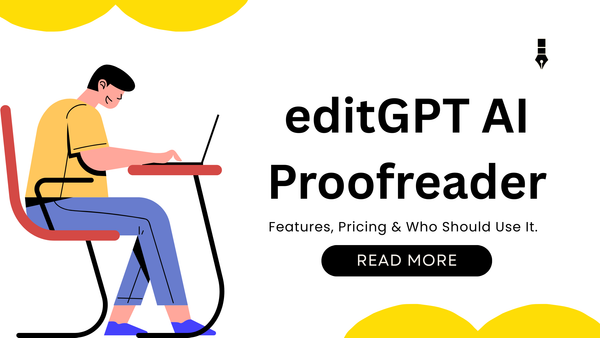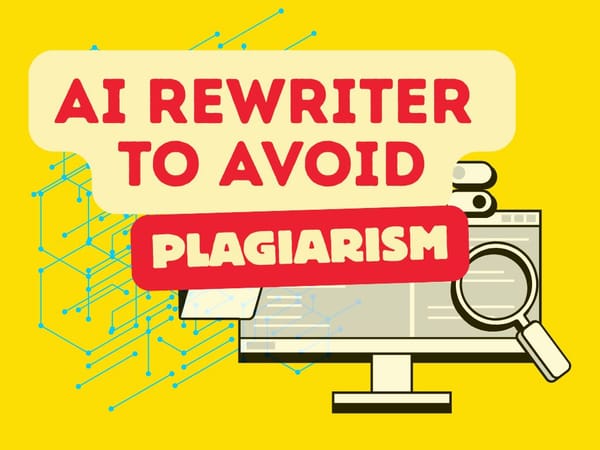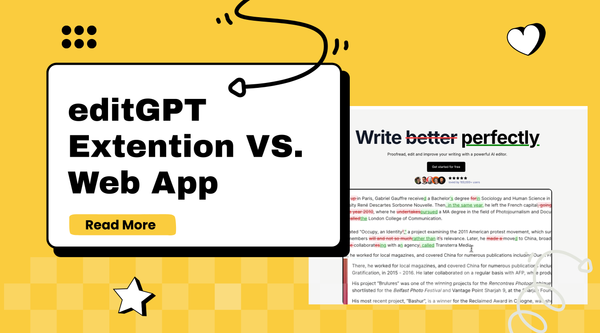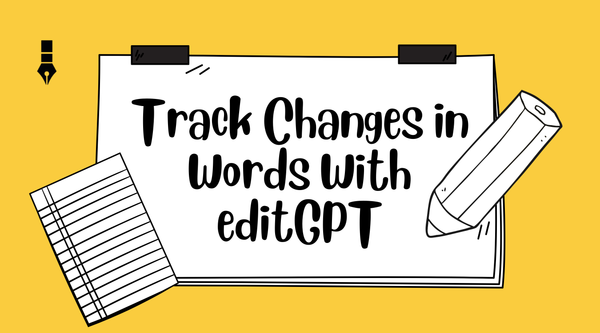Hemingway Editor vs editGPT: Which AI Writing Tool Is Better in 2025?
Hemingway Editor vs editGPT: Compare features, use cases, and strengths to find the best AI proofreader for your 2025 writing needs.

The two we're reviewing today are:
Two names keep popping up when the conversation is about AI proofreaders: Hemingway Editor and EditGPT. One cuts through the fluff like a knife, and the other proofreads like it can read your mind.
Both are excellent. But if you’re looking to invest in just one AI proofreader, it’s worth knowing where each tool shines (and where it doesn’t). That way, you can choose the one that truly matches your writing goals and workflow.
And that’s what this guide is for.
Like most writers, we’ve also relied on Hemingway App and EditGPT for years. But we put them through a fresh side-by-side test to see which one delivers the best results for unique writing styles and needs.
Let’s dive in.
Hemingway App and EditGPT: Which is the better sentence rewriter?
What the Hemingway App Does
Hemingway Editor is a web-based writing tool designed to help you craft clear, bold, impactful content. Its features are simple. It highlights common writing issues like passive voice, overly complex and hard-to-read sentences, excessive adverbs, unnecessary qualifiers, and more.
All that with the goal of tightening your writing.
As you might have guessed, this app was named after the famous writer who’s known for his punchy style. Though after using it for a while, you’ll realize that Hemingway App wants you to have very snappy outputs, instead.
The editor itself is distraction-free.
This tool’s minimalist design is a breath of fresh air for our tired writers’ eyes, and I love how easy it is to use. You just paste your content into the editor, and voila, instant feedback. You don’t even have to press one button.
Hemingway App has a highlighting system that may look intimidating at first glance, because there are quite a few colors of highlights.
- Blue highlights: adverbs or qualifiers
- Purple highlights: complex words that could be simplified
- Green highlights: passive voice
- Yellow highlights: lengthy or complex sentences
- Red highlights: extremely dense sentences that need revision
On the right side of Hemingway App’s interface, you’ll find your content’s readability grade. It’s a quick snapshot of how easy (or challenging) your writing is to understand. The scale starts from Grade 1 (super simple) and goes from there.
If you’re writing a light and casual piece, like a lifestyle blog post or a script, you’ll want to aim for a Grade 4 to 7. But hitting the target isn’t always easy.
Simplifying complex thoughts without dumbing them down takes time and effort (take it from our experience!), and Hemingway editor can be quite strict when it comes to trimming the fluff so your content can be as lean and clean as possible.
Now, that’s pretty much where Hemingway App’s functionality ends.
It highlights the issues, like hard-to-read sentences or passive voice. But then, it’s entirely up to you to interpret those suggestions and make the edits.
In other words, it won’t rewrite my sentence or automatically correct anything. You’ll have to figure out how to “please” the app until the highlights disappear.
That’s one of Hemingway App’s limitations.
While its simplicity is great for focus, it can feel a bit too bare-bones if you’re looking for a full-fledged proofreading assistant.
That said, the app has recently introduced a paid AI-powered writing assistant. However, this upgrade is locked behind a subscription.
An Individual 5k Plan costs $8.33 per month, billed annually or $100 per year. This plan gives you 5,000 AI sentence corrections per month, while the Individual 10k Plan doubles the AI editing capacity to 10,000 and costs $12.50 per month or $150 per year.
Hemingway App also has a desktop program version that lets you edit offline and export into different file formats. That said, it’s pretty much the same functions as the web edit,or with the exception of the desktop’s formatting ability.
What EditGPT Adds
If we were to describe EditGPT, we’d say that it’s like a very patient editor sitting right beside you. One who doesn’t just highlight corrections, but also explains why they matter, helping you improve as you write.
EditGPT excels in contextual editing.
Add that to its full suite of features, and you have a full AI writing assistant that will do all the work for you.
EditGPT is an AI-powered proofreader and editor built on top of ChatGPT, and it’s designed for writers who want deeper and smarter proofreading assistance.
It’s not like most grammar checkers.
The first thing that struck me was just how smart it is. EditGPT goes well beyond surface-level errors (think: more advanced than Grammarly). It helps you refine your writing style, tighten your content’s structure, and even adjust the tone to match your intent.
Did I mention earlier that it edits like it can read your mind?
EditGPT works as a Google Chrome extension, so it’s very easy to use, and you can use it while you’re writing in your favorite platform, may it be Google Docs, Notion, or Medium, among many others.
I didn’t have to copy and paste anything, and that convenience is very appreciated.
And that’s not all.
One thing that most new users notice is its standout intelligence and context awareness. EditGPT doesn’t just flag issues. It will explain to you why that particular sentence (or your whole content) needs editing before offering smart suggestions that don’t sound or look robotic but instead, natural and realistic.
Full artistic control? You can choose how in-depth the feedback will be, depending on your needs. You can also accept or reject suggestions.
And another great thing about EditGPT is that it's an AI proofreader, after all. It will learn from your preferences and previous edits to improve future suggestions, creating a personalized editing experience over time.
EditGPT is available to be used for free with a limit of 10,000 words per month and improved multi-language detection and support.
Its Pro Plan ($12 monthly) gives you 300,000 words monthly, has batch editing mode, and is perfect for longform editing or project mode. Its highest tier is the Elite Plan, costing $25 monthly with 2,000,000 words and more added features every week.
Who should use Hemingway App or EditGPT? A Use Case breakdown
There’s no one-size-fits-all when it comes to editing and proofreading tools. You might be a student who needs a smart proofreader that improves your schoolwork and helps you learn along the way.
Or maybe you’re a business owner, a content creator, or a busy professional who just wants to polish your writing without overthinking it.
This is exactly why we looked at these tools through different lenses, so you can see which one truly fits your writing needs.
Students and Academics
Hemingway App can be a helpful starting point for students who want to simplify their writing and improve readability. It also helps the users to become more aware of common issues such as passive voice and wordiness.
However, Hemingway editor stops short at suggesting improvements. You’ll have to figure them out yourself, which can be a good learning opportunity if you’re a student.
As for academic writers, Hemingway App can help with making your output more digestible for the readers by simplifying complex topics.
That said…
Hemingway isn’t really built specifically for academic writing. It doesn’t understand citation styles, formal structure, or the subtle shift of tone required in research papers. Its insistence on short sentences and plain language might clash with the evidence-driven style often expected in higher education.
EdiGPT, on the other hand…
…offers a more hands-on support. As mentioned earlier, it won’t only highlight the issues for you, but also give you the improved rewritten version while also letting you know why and how they came to be.
Academic papers and research assignments?
EditGPT is perfect for that as this proofreading tool can edit long-form content while observing the right structure and flow matter in addition to grammar check.
Marketers and Copywriters
This is where Hemingway App could shine, as marketing copy usually calls for short, snappy, and bold statements.
Hemingway’s focus on trimming fat content will work well with product descriptions, taglines, or landing page headlines.
That said…
…it can also make your copy plain and lacking when you need them to be persuasive and emotional as trimming them down means flattening them out when it comes to tone and personality.
How about EditGPT?
EditGPT can literally do anything, so it can also adapt more fluidly to the vision you want for your marketing content.
It recognizes tones, whether it’s professional, friendly, salesy, or formal, and then tailors suggestions to match.
Conclusion
Choosing between Hemingway App and EditGPT boils down to what you need and expect from your writing tool.
Hemingway App can be helpful if you already have a strong grasp of grammar and you only need help with tightening or simplifying your content. Realistically, Hemingway doesn’t do much, and for some, that’s just the point.
But for most writers and people who need a writing and editing aid, its simplicity can quickly turn into a limitation.
By contrast…
EditGPT works more like an editing partner than a tool. It understands the context and intention before identifying what needs fixing and suggesting clearer and better alternatives.
And don’t forget that it’s made on top of ChatGPT, so it can pretty much do anything you need it to, but with editing and proofreading as its main focus.
As someone who hates switching between tabs and apps just to get through revisions, EditGPT was a welcome relief, especially when I’m editing a long-form content.
Having a smart editor built right into my workflow didn’t just help me save time, it has also made the whole process smoother and more efficient.
Recommended Reading
- Video review: This AI Text Editing Tool Is FLAWLESS!
- Best AI Proofreader Tools of 2025 (Tested for Accuracy, Speed & Tone)
- editGPT vs Grammarly vs Quillbot: Which Writing Tool is Best?
- The Best AI Proofreaders That Actually Work (Free & Paid)
- Try editGPT
- Review: Wordtune Editor vs editGPT
- Review: Grammarly vs editGPT
- Review: ProWritingAid vs editGPT
- Review: Hemingway Editor vs editGPT
- Review: editGPT vs Trinka AI: Which is the best Grammarly alternative?
- Best AI Tools for College Essay Editing in 2025
- What is the best AI Proofreader?
- Best AI Proofreader Tools of 2025 (Tested for Accuracy, Speed & Tone)



